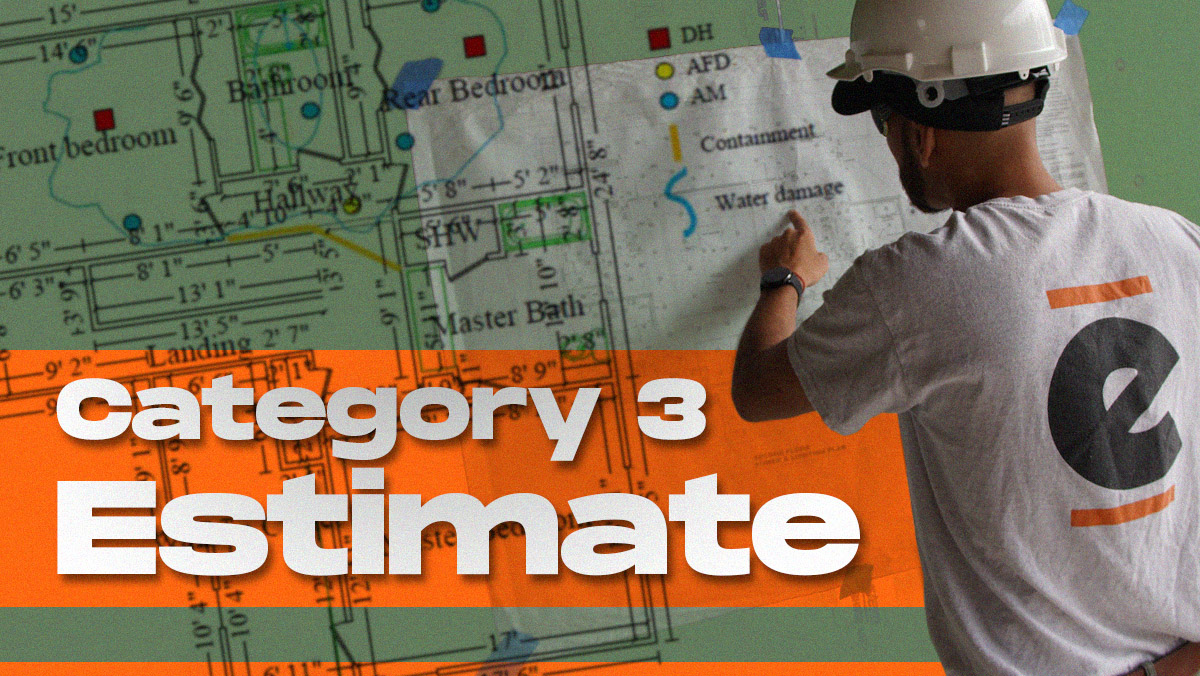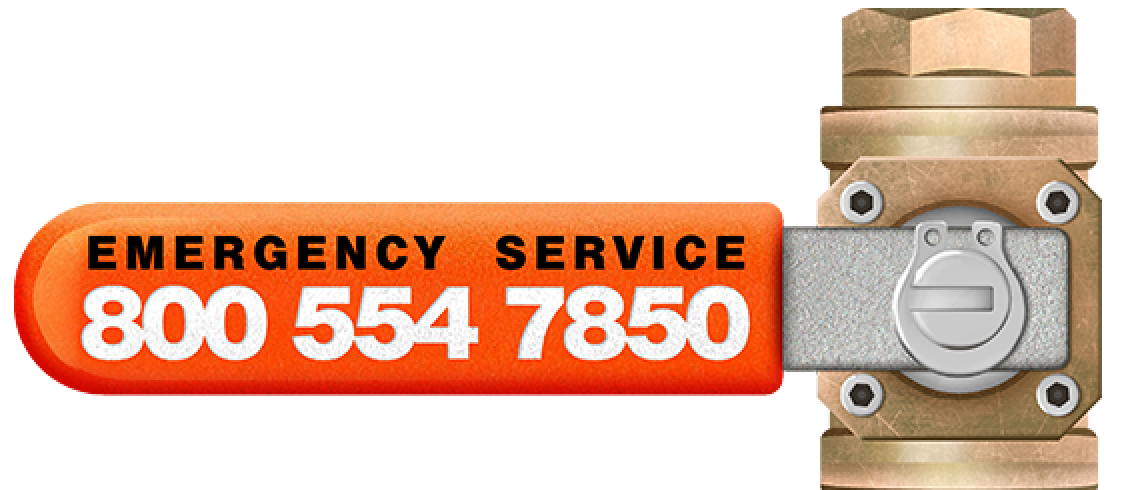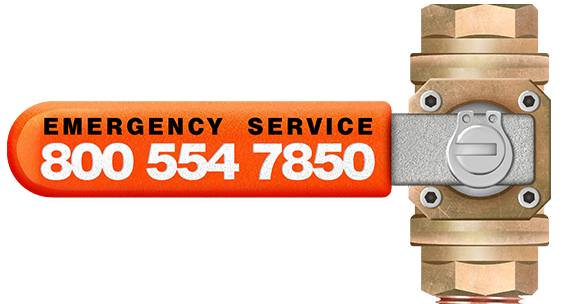Water Damage Series – Part 15: Category 3 Estimate
A Category 3 estimate, compared to categories 1 and 2 estimates, is a lot of the same and more. As we’ve reviewed the estimates for category 1 and 2 losses you’ve been introduced to the elements of the estimate as well as examples of many of the line items that could appear. With this third post about estimates, you will have seen only a fraction of the line items that are possible. But from this series, you should be able to have a good understanding of any estimate provided you.
Asterisks on an Estimate
The lines used in an estimate could say anything. An estimator could write anything they choose as the description. This is a good thing because it allows them to explain in greater detail if needed.
In line 1 below we see Dispatch fee – Incl. first monitoring charge*. It is fairly clear what that is for and what it covers. When we see an asterisk (*) in text we are accustomed to looking for a footnote to explain further details. That isn’t how it is used in an estimate.

When the estimator needs to provide additional clarification about the line item, it is entered right there. There is no need for a footnote. You can see this in lines 2 and 3 where it lists the date and description: 08/11 – Follow up.
Instead, the asterisk is used to draw attention to the line. It is likely, that in this case, the estimate had been submitted to the adjuster who asked for clarification about the estimate or specific lines. Upon a second review of the estimate, the adjuster could quickly identify the line in question simply by scanning the page for the asterisk.
It is also possible that the asterisk was a typo, though less likely. Either way, it would not be something of concern, and more importantly, don’t go looking for a footnote because it won’t be there. All notes about the line item will be with the initial description.
Expect PPE in a Category 3 Estimate
In a category 3 loss you are dealing with toxic water or potentially toxic water. This means that personal protective equipment (PPE) will need to be used. In line 8 below it identified the item, N-95 masks.

One of the things I like about this example is the note that on the first day of the water loss there were five techs working on site. It really helps build the picture of how much was involved with the cleanup.
Estimates Often Use Shorthand
In this example we see that there was a lot of equipment needed for this loss. Twelve pieces of equipment specifically.

As mentioned in a previous post, it is common for industry jargon to be used. Here we see that abbreviations are not uncommon either. This happens because the estimator and the adjuster are usually the only people who read these estimates and they understand one another. When the adjuster tells a homeowner that they will pay the mitigation costs and no extra cash from them is necessary, homeowners don’t review the estimates.
These abbreviations stand for dehumidifier (DH), air mover (AM), and air filtration device (AFD). Other terms might also be used, for example, dehu is often used as shorthand for dehumidifier.
Since this was a category 3 loss with toxic or potentially toxic water, all of the equipment used needs to be fully decontaminated before being redeployed at the next home. Since there is a cost associated with it, this cleaning is listed as its own line item.
A Little About Containment
We’ve talked a little about containment in the previous estimates, and we’ll go into the reasons a little more here. As the notes to line 12 states, the strategy here was to create a drying chamber. It serves two purposes.

When you look at the sketches at the end of this post you can see that creating a barrier helped prevent contaminating the rest of the house. But it also helps to accelerate the drying.
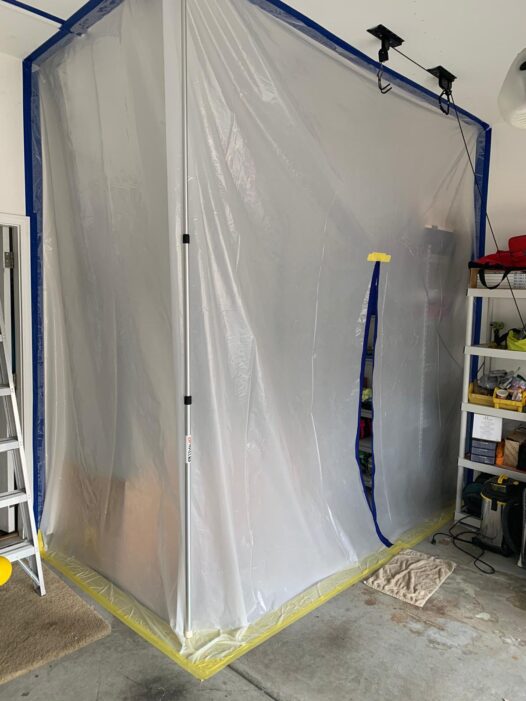
You may have noticed the Peel & seal zipper – heavy duty reference in previous examples. When we create a plastic barrier the technician still needs to pass through that barrier. To do that, the peel & seal zippers are used. As seen in this picture of a containment setting, the zipper has been added to the plastic barrier.
These zippers will also be used by homeowners when they might still need access to the drying area throughout the duration of the dry out. In this case, the kitchen is contained. For some reason, homeowners always seem to want access to the kitchen.
On Every Category 3 Estimate
Because Category 3 water is contaminated water, every estimate will include some sort of cleaning. In this section you can see not only the anti-microbial agent, but the non-salvageable carpet components.

Anytime there is category 3 water, the carpet will need to be removed and disposed of along with the carpet pad and tackless strip.
The cleaning will be applicable to at least those places in the home where the Cat 3 water touched. The anti-microbial solution will not slow down the drying process but will protect you from contamination in the water.
Water Damage Often Brings Mold
When there is a lot of water there is a dramatically increased chance for mold. What this section of the estimate does is tell the adjuster (and homeowner) that the room listed was inspected for signs of water damage. Since none was found there are no costs associated with mitigating for it. In this case, it also shows that there was no charge for the visual inspection.

The inspections done for water damage are generally non-invasive. That means just looking for damage that can be seen with the naked eye. If you have a concern that there might be hidden damages and ask for invasive methods, you should expect to see costs associated with that work.
The other thing that this reference does is point out, for the homeowner’s edification and benefit, that even though water damage is not apparent, it is possible that mold might result from high humidity levels. This might be important if you have mold coverage in your policy. If the water claim was a covered claim, then a mold claim arising out of the same incident should also be covered.
Third-Party Administrators Often Review the Estimates
To this point, we have never mentioned a reviewer. But there is another aspect of working with insurance companies, and that is that some carriers work through Third Party Administrators (TPAs). These are third-party companies that will work as an intermediary between the mitigation company and the insurance company.
One of their functions is to ensure that when the estimates are written and submitted to the adjuster, that they follow the guidelines specified by the carrier. This topic is too large to include here in totality, but suffice it to say, their role is to review the estimates before the adjuster sees them. Line 40 is an example of why.
Line 40 shows that the technician will be tearing out wet drywall. It isn’t a foregone conclusion that the removal of drywall will be covered. In fact, the note that says Adjuster approved to remove water damage drywall is an indication that according to the carrier’s guidelines, the removal of that drywall is not part of their standard practice.

The reason this is listed isn’t to remind the adjuster that he approved it. Rather, it helps the reviewer know that the adjuster is already aware of the situation and has approved the expense.
The TPA is a helper to the insurance company, but they cannot approve or disallow any repairs or expenses associated with this claim, ONLY the adjuster can claim financial responsibility on behalf of the carrier.
The Total Cost
By reviewing these estimates you can get a sense of what things might be included in the total cost of water damage mitigation, but every situation is unique. We’ve seen a Category 1 estimate of around $600 and a Category 2 estimate of around $2600. Here we find a Category 3 estimate for more than $6700. You can have a Cat 1 be much more than even this estimate and a Cat 3 be much less because of the size of the loss. The Classification of the loss is a big factor, but there is certainly a correlation between the increased category and the increase in costs associated with cleanup.

Sketches Help You Understand the Scope of the Damage
In the Category 1 estimate post there is a sketch of the area affected by water. It was caused by rainwater coming in a broken window and only one room was affected.
The loss shown in this post happened inside the house caused by a broken pipe in an upstairs bathroom. There are two sketches for this loss, one for each floor.
Look closely at this sketch. You’ll see the source identified with a light blue oval. It’s a bathroom. You see the squiggly blue line that shows how far from the source the water flowed. It affected three rooms and a hallway.
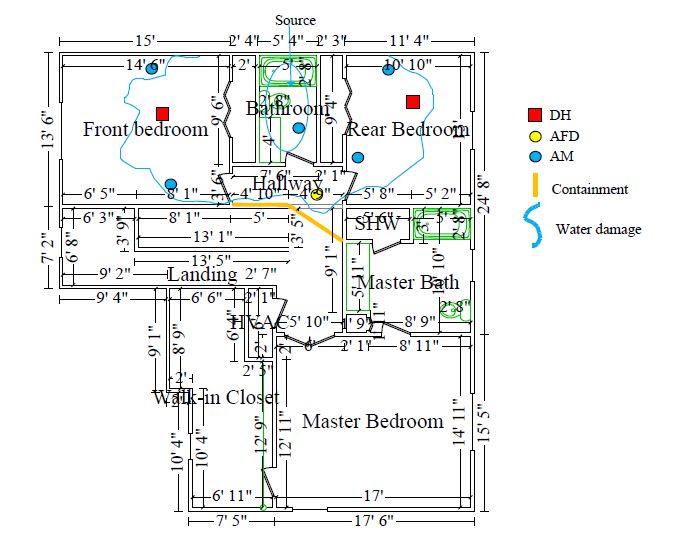
The sketch is mostly beneficial to your adjuster so they can see the deployment of equipment and the protective measures of containment. If you are at the house, you can see and don’t need the sketch. But if you are a landlord out of the area, this sketch will help you see the work done.
The air filter and containment do a fine job of limiting the impact of the disaster. While the water isn’t going to extend to other rooms, without the containment, mold spores would more easily migrate to the rest of the house.
Downstairs Area Affected
Unfortunately, the floors only provide limited protection from water damage spreading. Take a look at how the downstairs was affected by the disaster.
Fortunately, the floors do provide some protection. How much protection can be seen in the sketch for the downstairs. It shows that water did leak through the floors and damaged the ceiling below.
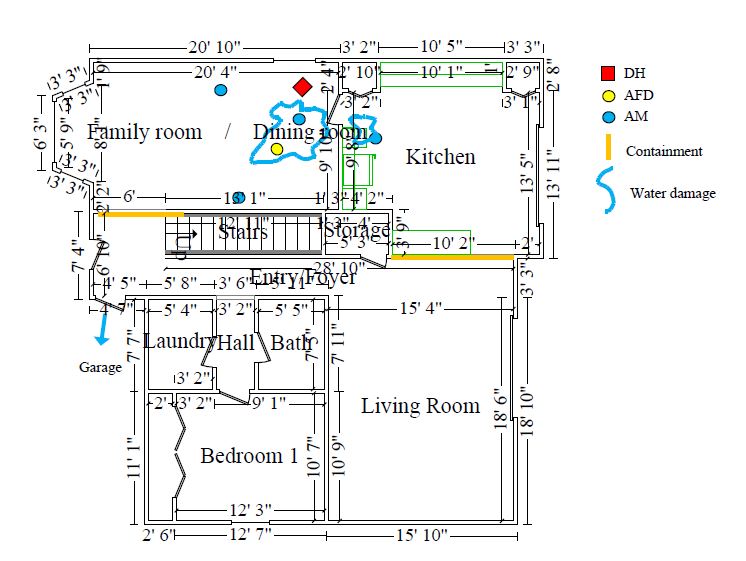
Looking at the first page of the estimate we see:

This shows that there were four days between the time the loss was discovered and when our technicians were able to inspect and place equipment. The property had been vacant for three weeks before the loss was discovered. A drip in the toilet water supply line was the cause. It isn’t known how long the drip had been going.
This situation highlights the importance of catching problems early and arresting them before the failure spreads. If not tended to early, a Cat 1 loss could become a Cat 2 and a Cat 2 can become a Cat 3. The increase in cost should be evident in this Category 3 estimate and those increased costs will almost invariably extend to the cost of repairs when the build-back phase begins.
Conclusion
There you have it, three examples of estimates, one from each category of loss. In addition to the category of water loss, the scope of the loss, as defined by the classification, shows that there are no bounds in how a water disaster can hurt a home.
Every loss is different. Every estimate will therefore be different. There are so many more lines that could be found on an estimate used for a loss at your home. If there are circumstances that have not been anticipated by the preprogramed lines in Xactimate or the exhaustive price list feature, the estimator can add anything that is needed and price it according to market conditions.
That’s what we’ll discuss in the next post, legitimate vs. illegitimate line items found in a mitigation estimate.





